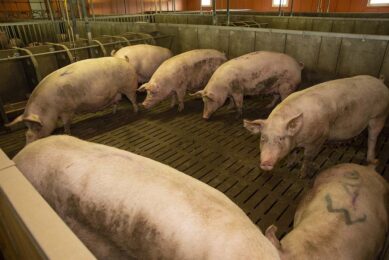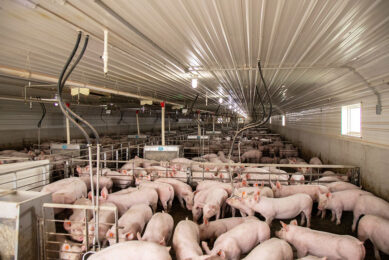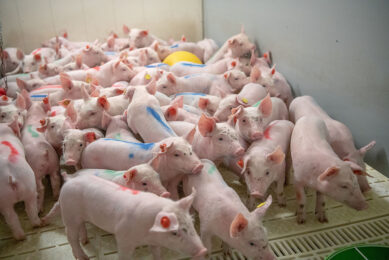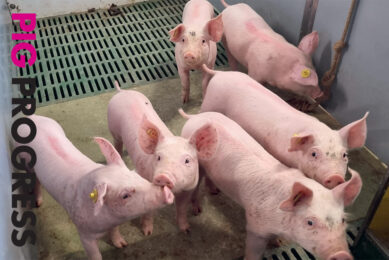BPEX Two Tonne Sow: Colostrum key for piglet survival

More than 300 producers attended the Two-Tonne Sow (2TS) ‘Focus on Farrowing’ conferences, organised by the British Pig Executive’s Knowledge Transfer team. Four technical experts joined local pig producers to discuss management of both the sow and piglet to deliver a strong litter through to weaning.
The reason behind the 2TS seminar series is partly related to history – in 1997 top indoor producers in the UK were weaning 25-26 pigs/ sow/ year. Much, however, hasn’t changed since then, partly related to heavy Foot-and-Mouth Disease (FMD) and Postweaning Multisystemic Wasting Syndrome (PMWS) outbreaks.
By using the 2TS approach, BPEX hopes bit by bit to raise average levels of British production.
Stillborn piglets
Dr Emma Baxter, a researcher based at the Scottish Agricultural College (SAC), highlighted the big problem of stillborn piglets. “It amounts to 900,000 stillborns per year, effectively costing the industry £38 million (€43 million) plus with the trend to hyperprolific sows having bigger litters, this number will inevitably rise.”
Generally it’s assumed that stillbirths are associated with low birth weights, but research by Roehe (2003) indicated that the optimum birth weight was 1.6 kg and that as birth weights increased so did the stillbirth percentage, as ironically bigger piglets are more likely to get stuck during farrowing.
She indicated that older sows have poor muscle tone and poor uterine condition so take longer to farrow and because of this, as well as other reasons, culling should take place generally after six litters. She added that farmers keep good farrowing records as repeat ‘offenders’ may need extra attention. Sows that are over-fat and conversely emaciated can both have trouble farrowing and so a condition score of 3 is recommended.
Baxter also said that maternal stress must be reduced and sows need to be kept cooler than the piglets – the ambient temperature in the farrowing house should be 20 degrees Celsius. Giving the sow a nesting substrate, e.g. straw will reduce the sow’s behavioural stress, allowing nesting behaviour to be displayed.
She added that nutritional supplements, like ‘sports drinks’ give an energy boost to reduce farrowing time and high fibre feeds such as sugar beet pulp or bran act as laxatives and physically clear the gut, making expulsion of piglets easier. Giving sows cod liver oil would be another option, she said.
Oxytocin is used to speed up farrowing, commented Dr Baxter but it can result in the early rupturing of the umbilical cord hence farrowings need to be supervised if oxytocin is used.
During the Post-weaning Multisystemic Wasting Syndrome (PMWS) outbreaks, UK farms cut back on labour to cut costs and many farms are still understaffed, she said. Staffing the farrowing house 24 hours a day as happens in Asia can’t be justified given European labour wage rates but having staff on hand over the period when sows are farrowing is undoubtedly cost effective, to assist sows in difficulty plus stopping piglets choking in the afterbirth etc. Where batch farrowing is in operation staff should be available for full time farrowing house supervision anyway.
Elixir of life
Dr Yannig Le Treut, Lallemand Animal Nutrition, then spoke about the topic ‘Colostrum, the elixir of life’. He said that it’s imperative that piglets get adequate colostrum as it contains vital antibodies for immune protection, it is high in energy, proteins, vitamins and trace minerals and is important for gut maturation.
At birth the piglet has no immune protection at all hence it’s vital that as soon as the piglet is born it gets on a teat and ingests colostrum. If the farrowing house is staffed then piglets can be watched and if necessary be helped on to a teat, something to be noted if sows are routinely induced, as induced sows produce less colostrum, both in terms of quantity and quality. As litter size increases, colostrum intake/ piglet decreases.
So as there is a trend to hyperprolificacy, it’s vital the piglet is able to suckle quickly and is kept warm, plus drying agents will help reduce evaporative heat loss from the piglets’ body , stop chilling occurring and ensure the piglet is lively. The piglet’s gut can only absorb colostrum for a short time after farrowing.
Le Treut continued to say that each piglet should get at least 100 g/ kg bodyweight of colostrum to allow the passage of lymphocytes and piglets should be marked and then locked in the creep or a box after their first colostrum intake, allowing later born piglets to get their fair share of colostrum as well. Consequently, cross-fostering should be delayed until 24 hours post farrowing. Colostrum drenching is also possible, using frozen/ thawed colostrum. Colostrum substitutes are available and are another weapon in the armoury.
Rescue decks
Ensuring good colostrum intake will help keep those piglets alive and with big litters comes the not unwelcome problem of rearing them all. Supplemental milk systems are in vogue again and Andrew Zarkos-Smith of Zarkos-Smith Associates highlighted the use of rescue decks to keep more piglets alive.
These slatted heated boxes which house around 12 pigs are positioned in the farrowing house and fixed on top of the farrowing crates. Milk substitute is mixed in a small tank and then circulated via a pipeline through the decks, with the piglets drinking the milk from mini bowls. With the decks being in the farrowing room the piglets can hear the sow calling her piglets to suckle naturally and the deck piglets also ‘suckle’ at the same time.
One delegate raised the question of whether the fact that these piglets were arguably weaned breached current EU welfare codes, but a veterinary opinion was that the deck system was acceptable given that the piglets were still in the same room as sows. Also the decks are taking surplus piglets to stop them starving, i.e. improving their welfare plus the sows are still being weaned at the normal age.
Sow nutrition and condition
Dr Phil Baynes, Baynes Nutrition, addressed some aspects of sow nutrition plus the importance of sow condition. Its vital that sows don’t lose too much weight in lactation- easier said than done with hyperprolific sows – but producers should aim for sows to have a P2 fat depth of 16 mm at service.
“There are small handheld devices on the market which can be used to obtain this measurement,” Baynes commented. With regard to feeding in pregnancy, increasing feed by 1.5x above that given from service for 25 days from circa day 27 increases ‘meat muscle’ mass expressed from day 70 onwards and improves litter uniformity. Inclusion of fish oil particularly the last three weeks of pregnancy results in heavier birth weights, better litter weight gain and lower pre-weaning mortality, Baynes said, adding that fish oils do vary in their fatty acid content.
Finally Baynes flagged up the big problems caused by mycotoxins.in feed ingredients. Zearalenone, for example, causes infertility and abortion and toxin binders are part and parcel of pig production in the 21st century.
He said, twenty years ago, mycotoxins were bottom of the list when it came to possible causes of abortions and infertility. Today they should be at the top.
The three events were held in Cirencester, Stowmarket and Wetherby, UK. To view the full presentations from all speakers visit www.bpex.org.uk/2TS/events.aspx.
(By Stuart Lumb)
Join 18,000+ subscribers
Subscribe to our newsletter to stay updated about all the need-to-know content in the pigsector, three times a week. Beheer
Beheer










 WP Admin
WP Admin  Bewerk bericht
Bewerk bericht